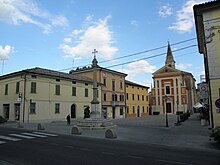Baricella
| Baricella | ||
|---|---|---|

|
|
|
| Country | Italy | |
| region | Emilia-Romagna | |
| Metropolitan city | Bologna (BO) | |
| Local name | Barisèla | |
| Coordinates | 44 ° 39 ' N , 11 ° 32' E | |
| height | 11 m slm | |
| surface | 45.62 km² | |
| Residents | 7,254 (Dec. 31, 2019) | |
| Population density | 159 inhabitants / km² | |
| Post Code | 40052 | |
| prefix | 051 | |
| ISTAT number | 037003 | |
| Popular name | Baricellesi | |
| Patron saint | Natività BVMaria | |
| Website | Baricella | |
Baricella is an Italian municipality with 7254 inhabitants (as of December 31, 2019) in the metropolitan city of Bologna .
history
The first documents about the city of Baricella date back to the 13th century, when the development of the city center gradually began.
Originally it formed a single community with the parish of Altedo and, together with Minerbio, was part of the former area of the Valle dei Conti (Valley of the Counts). The floods from the Savena River caused the lands to become swampy and inhospitable at least until the early 14th century. The original place name Guazzarello (from the Italian guazzare , i.e. to wade ) is derived from this.
The municipal coat of arms still indicates the historical location of the area at that time. It shows a fish, the most important food in the lowlands of the Savena River, and a passing ferry that shuttled in the Canale Navile until the Cavo Benedettino was expanded in the 17th century and was stationed in the village of Passo Segni .
The first documents to mention Baricella date from the 15th century. At that time, the administration of Baricella was separated from the city of Altedo because of the many difficulties in developing both places as a result of the frequent floods. The origin of the name derives from the eastern border crossing in the municipality between the Republic of Bologna and the city of Ferrara administered by the Este (family) Estes . The place was on the Savena and was characterized by a flourishing legal and also unauthorized freight traffic, so that the officials of Bologna chose the village as the seat of the Bargelli (officials with special tasks such as police service and customs surveillance).
The expansion of the parish church in 1461 proves the prosperous situation of the population, which at that time had become too small for the demands of an ever-growing community.
At the beginning of the 16th century the area status was raised to county and offered to the cousins Lattanzio and Ludovico Felicini . Shortly afterwards, however, the county was abolished because the Pope feared that an excessive number of fiefs could limit the superiority of the city on the countryside. That is why the place came back under the rule of the Senate of Bologna .
19th century
In the 19th century, numerous soil remediation works were undertaken throughout the area. Thanks to the administrative division of the Napoleonic era and, above all, the industrialization of the area at the end of the 19th and beginning of the 20th century, a tramway between the town and the city center of Bologna was built in May 1891. In this age an exhibition center was established that still attracts numerous visitors today. In 1828 a small theater was built, of which only the traces can be seen today. It was located in the former Casa Zucchini, now called Casa Ballandi, on whose walls you can still see decorations and pictures in the neo-classical style.
Individual evidence
- ↑ Statistiche demografiche ISTAT. Monthly population statistics of the Istituto Nazionale di Statistica , as of December 31 of 2019.


